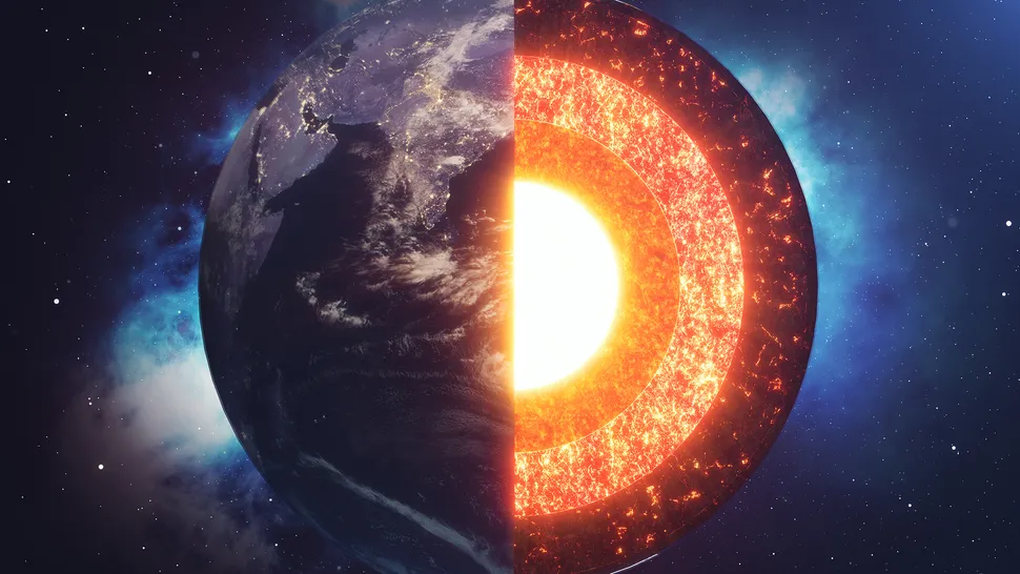
The iron-rich core at the Earth's center plays a crucial role in the planet's evolution. It not only powers the magnetic field—a shield protecting the atmosphere and oceans from solar radiation—but also drives plate tectonics, constantly reshaping the continents.
Despite its importance, many fundamental properties of the core remain a mystery: how hot is it actually, what is it made of, and when does it begin to freeze? A recent discovery has brought scientists closer to answering all three questions.
The inner core is estimated to have a temperature of around 5,000 Kelvin (4,727°C). Initially in a liquid state, the core gradually cools over time, crystallizing into a solid component and expanding outwards. This heat release creates tectonic plate flows.
Cooling is also the source of the Earth's magnetic field. Much of today's magnetic energy is sustained by the freezing of the liquid outer core, which powers the solid core at its center.
However, because direct access is impossible, scientists are forced to rely on estimates to understand the cooling mechanisms and properties of the core. To clarify this, the most important factor is determining its melting point.
Thanks to seismology – the science that studies earthquake waves – we know exactly where the boundary between the solid and liquid cores lies. The temperature at this boundary is also the melting point, the starting point for freezing.
Therefore, if the melting point could be determined precisely, humans would gain a better understanding of the true temperature of the core and its internal chemical composition.
Mysterious Chemistry
There are two main approaches to understanding the composition of the Earth's core: studying meteorites and analyzing seismic data.
Meteorites are considered "remnants" of planets that hadn't yet formed or fragments from the cores of planets that had already been destroyed. Their chemical composition suggests that Earth's core is primarily composed of iron and nickel, possibly with a few percent silicon or sulfur. However, this data is only preliminary and not detailed enough to confirm anything definitively.
Meanwhile, seismology provides a much more concrete view. Seismic waves from earthquakes, as they travel through the Earth, change speed depending on the type of material they pass through. By comparing the time it takes for the waves to reach monitoring stations with experimental results on transmission speed in minerals and metals, scientists can construct models of the planet's internal structure.
The results show that the Earth's core is about 10% lighter than pure iron. Notably, the outer core, which is in a liquid state, is denser than the inner core, a paradox that can only be explained by the presence of some extraneous elements.
However, even after narrowing down the possible composition, the problem remains unresolved. Different scenarios yield melting temperatures that vary by hundreds of degrees Celsius, making precise determination of core properties a challenge.
A new restriction
In new research, scientists used mineralogy to understand how the Earth's core began to freeze—a more specific approach than both meteorology and seismology.
Simulations show that when atoms in liquid metal crystallize into solids, each alloy requires a different level of "supercooling," that is, being lowered below its melting point. The stronger this process, the easier the liquid freezes.
For example, water in a freezer can remain extremely cold at -5°C for hours before freezing, while a droplet of water in a cloud turns into hail in just a few minutes at -30°C.
Calculations show that the maximum supercooling temperature of the core is approximately 420°C below its melting point. If this temperature is exceeded, the inner core would be unusually large compared to seismic data. Meanwhile, pure iron requires 1,000°C to crystallize, which is impossible, as the entire core would have solidified by then.
Adding silicon or sulfur doesn't help; it might even require the core to be supercooled further.
Only when carbon is considered does the picture make sense. If 2.4% of the core's mass is carbon, approximately 420°C is needed to freeze the inner core; with 3.8% carbon, this drops to 266°C. A much more plausible figure. This is the first evidence suggesting that carbon plays a crucial role in the core crystallization process.
However, the core couldn't possibly consist solely of iron and carbon, as seismic data suggests the presence of at least one other element. Research suggests the possibility that the core also contains oxygen, or even silicon.
Source: https://dantri.com.vn/khoa-hoc/loi-trai-dat-chua-dung-nhung-gi-20250923025913011.htm



![[Photo] Prime Minister Pham Minh Chinh attends the Conference on the Implementation of Tasks for 2026 of Vietnam Television.](/_next/image?url=https%3A%2F%2Fvphoto.vietnam.vn%2Fthumb%2F1200x675%2Fvietnam%2Fresource%2FIMAGE%2F2026%2F01%2F10%2F1768047311329_ndo_br_dsc-3214-jpg.webp&w=3840&q=75)





















































![[Infographics] Resolution No. 79-NQ/TW of the Politburo on the development of the state-owned economy](https://vphoto.vietnam.vn/thumb/402x226/vietnam/resource/IMAGE/2026/01/10/1768038914679_chp_3-11-23.jpeg)



















































Comment (0)